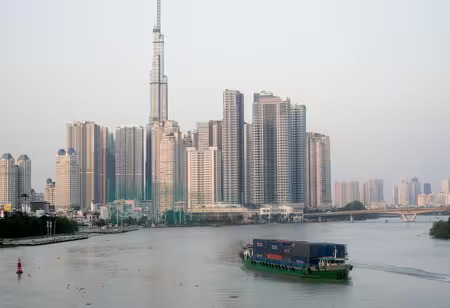
Vietnam Seeks to Achieve Prosperity by 2045


Under crimson flags and a golden statue of revolutionary figure Ho Chi Minh at Hanoi's central party school, Communist Party leader To Lam announced the onset of “a new development era” late last year. The address was not merely symbolic—it marked the beginning of what might be Vietnam's most ambitious economic reform in years.
Vietnam seeks to achieve prosperity by 2045 and emerge as Asia’s next “tiger economy,” a phrase that refers to the previous rise of nations such as South Korea and Taiwan.
The difficulty before us is significant: Balancing expansion with necessary reforms, an aging demographic, climate threats, and strained institutions. President Donald Trump is exerting additional pressure regarding Vietnam's trade surplus with the U.S., highlighting its impressive economic growth.
Also Read: 5 Surprising Business Leaders Who Attended Trump's Inauguration
In 1990, the typical Vietnamese individual could purchase roughly $1,200 in goods and services annually, when considering local price adjustments. Currently, that amount has increased over 13 times to $16,385.
Vietnam's evolution into a worldwide manufacturing center characterized by modern highways, towering skylines, and a flourishing middle class has pulled millions of its citizens out of poverty, much like China. However, its affordable, export-driven growth is decelerating, as the suggested reforms — broadening private sectors, enhancing social safety nets, and investing in technology and renewable energy. It encounters an increasing challenge due to climate change.
“We all need to pitch in.Time is of the essence now,” stated Mimi Vu from the consultancy Raise Partners
Investment has surged, partly fueled by U.S.-China trade conflicts, and the U.S. has become Vietnam's largest export market. Previously calm suburbs have transformed into industrial zones where trucks roar through extensive logistics centers catering to international brands.
Also Read: A Lot of Weightlifting Awaits Lip-Bu Tan, But is Intel Ready for Him?
In 2024, Vietnam achieved a trade surplus of $123.5 billion with the U.S., provoking anger in Trump, who warned of a 46 percent import tax on goods from Vietnam. Both parties seem to have agreed on a 20% tariff, and double that for items believed to be transshipped, or directed through Vietnam to evade U.S. trade limits.
In talks with the Trump administration, Vietnam prioritized its tariffs concerning those of neighboring countries and rivals, according to Daniel Kritenbrink, a former U.S. ambassador to Vietnam. "Provided they are in the same area, in the same range, I believe Vietnam can accept that result," he stated. However, he noted that there are still questions about how much Chinese content in those exports might be excessive and how those goods will be taxed.
Vietnam had been readying to modify its economic strategies before Trump's tariffs jeopardizing its approach of producing inexpensive exports globally, cognizant of the phenomenon known as the “middle-income trap,” where economies often stagnate without significant reforms.
To progress further, South Korea focused on electronics, Taiwan on semiconductors, and Singapore on finance, according to Richard McClellan, founder of the consultancy RMAC Advisory.
But Vietnam's economy today is more diverse and complex than those countries were at the time and it can’t rely on just one winning sector to drive long-term growth and stay competitive as wages rise and cheap labor is no longer its main advantage.

